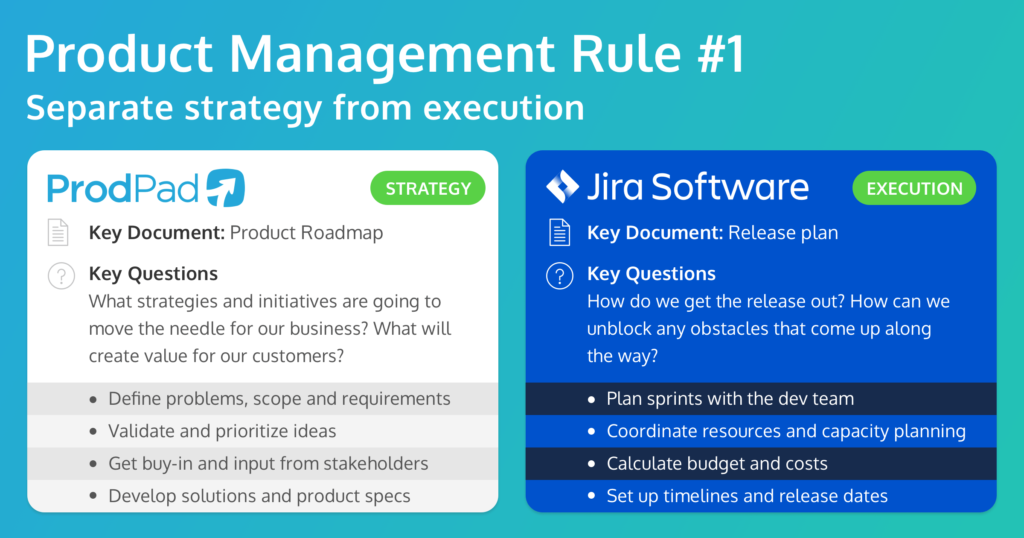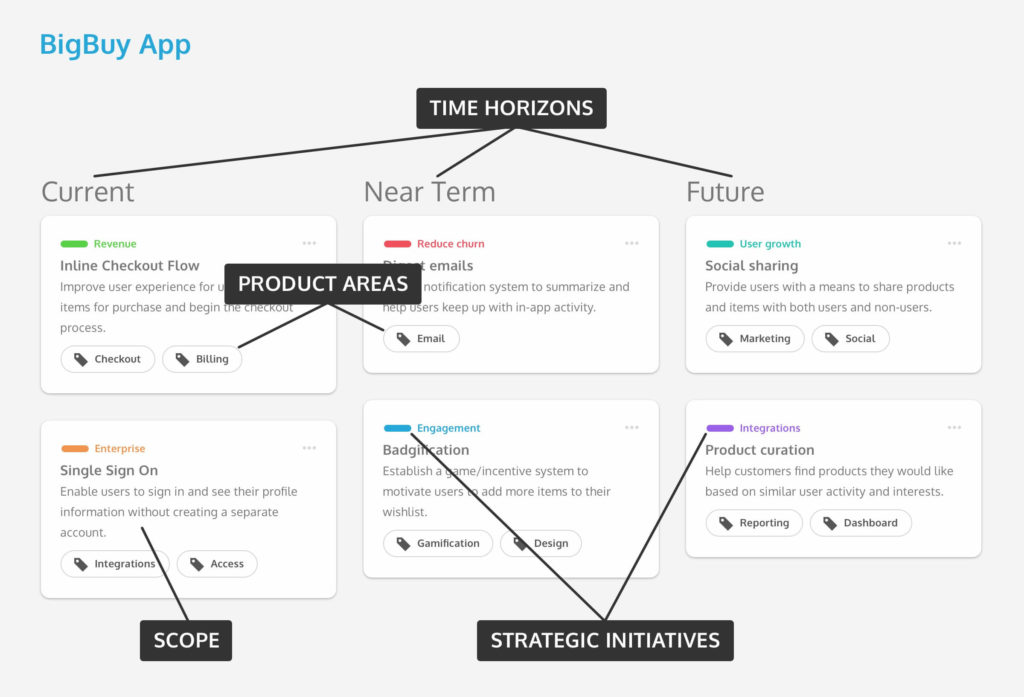How To Nail Your Jira Product Management Process
Raise your hand if you’ve tried to prioritize your product backlog in Jira. That’s everyone, right? But who has actually succeeded at it? Yep, just about no one. (If you’re the lucky exception, give me a shout!)
Using Jira for product management is like using a hammer to drive in a screw. It’ll get there, but it’ll be an ugly process and pretty much impossible to unwind.
James Mayes, Co-Founder at Mind the Product
Jira is a great development tool and it does what it’s supposed to do: it helps you to manage the completion of development tasks. Jira is where your dev team plan their sprints based on tickets that are fully formed and ready to go.
As a product manager, your job is different. Along with managing stakeholders and projects, you need to protect your dev team from outside interference. As a product manager, it’s your job to answer the question, “What should we work on next?”
We’ve all used Jira for product management backlogs because there hasn’t been a better way to manage them. However using Jira for product management also means that you create a lot of noise for your dev team to wade through – they don’t need to see what may or may not be built in the next sprint or quarter, or look into ideas that may never see the light of day.
As a product manager, you don’t want a list of stuff to build. Rather you need to figure out the right stuff to build. The right stuff is constantly evolving as you learn and iterate – and Jira is simply not designed to keep up with that.
The problem isn’t Jira. It’s how you’re using Jira. It’s time to think about splitting strategy and execution.
How To Build A Jira Product Management Workflow
The key to nailing product management with Jira is to break your process down into two distinct parts: strategy and execution.

Strategy is when you define what problems need to be solved, establish priorities and collaborate with stakeholders to develop solutions.
It’s your creative phase – the phase in which you collect up the data and information in your product backlog to figure out what to work on and how you want to tackle it. You establish your roadmap, validate ideas and iron out what you plan to accomplish.
This element of your workflow doesn’t play to Jira’s strengths and is better suited to a tool which has been specifically built for the job – like ProdPad.
Execution is when you knuckle down and build.
This is your production phase. You set up sprints, release plans, manage resources and develop what’s been sent over from the product team. This is what Jira is suited to.
In the diagram below the first three boxes show the strategy work that should be done in a tool like ProdPad, and the second three (green) boxes show the execution work that is suited to Jira.

From strategy through to execution
Using a tool like ProdPad that focuses on a product manager’s needs, rather than one that’s been designed for the dev team, means that you can define the differences between strategy and execution.
It’s a process that helps you to stay in control of what gets built and it means that nothing is left to chance. It also addresses one of the biggest problems of product management – that of leaving critical product decisions to the end when the dev team is about to pick up a ticket.
So before you move to execution in Jira for product management, you should be sure that your product specs are more or less solid. Are the ideas fleshed out and approved? Can developers open the task and see clearly and quickly what needs to be done? If the answer to these questions is yes, then you can push your product through to Jira and let the dev team do their stuff.
Using another tool for strategy means that Jira is only used for fully formed ideas. It means that you can work on what’s coming up next, and the dev team can work on what’s being built right now. And Jira is no longer a place where ideas go to die.
Get this strategy phase right and your dev team will know exactly what to build, and have lots of product context. It also gives you as product manager the space to build a roadmap of what’s coming up in the future.
5 Steps to Getting Your Strategy Right
1. Building your roadmap: Define your product vision and objectives
Don’t leave home without a product vision. Because… where are you going exactly? What value do you want to create for your customers? The product vision is the cornerstone of your product strategy and the anchor for every decision you make. That includes your business objectives (or OKRs), or the metrics by which you measure growth and success.

Even though your vision and objectives sit at the very top, they’re an important part of everyday product planning.
They help you to focus on ideas that matter to your business and what ultimately makes it on to your product roadmap. Without a product vision and objectives, your roadmap won’t have a clear focus.
2. Validate ideas in your product backlog
You should always be collecting ideas with a business case for your product backlog. It’s the beginning of the validation process. You always need a business case to understand what’s behind this new idea and what problem it represents. Without this you run the risk of losing focus and product/market fit.
We’ve designed ProdPad to collect ideas with a business case. When someone submits a new idea, ProdPad asks them why they’re submitting it before it creates an Idea Canvas.
The Idea Canvas is a powerful way of validating ideas. You can continue expanding your idea with all the following elements until it’s a fully-formed product spec, ready to take out of the backlog and move to Jira.
- Business case – how this will create value for customers or business?
- Impact vs. Effort – what is the impact on the business and for customers? Is it a huge project? How much time will it take? What about training?
- User stories – what is the user trying to achieve?
- User personas – who are you building this for?
- Designs – what should the final solution look like?
- Customer feedback – what are customers asking for?
The Idea Canvas is also the means by which you can educate your company to talk about the product and get more detail on the ideas in your backlog.
3. Look for themes in your product backlog (still strategy!)
The backlog is never as long as it looks. All those backlog items usually end up representing a handful of problems, which we call themes.
Themes are what you should really be going after. They represent the root of the problem that you want to solve for your customers.
Themes show you the scope of the problem and give you the bigger picture view of what needs to be solved. If you can identify themes, you can dramatically reduce the number of ideas you need to juggle.
For example, look at how these three different product ideas really point to just one problem area: the inline checkout flow.

In this case, Inline Checkout Flow is the theme (and you can see its objective is Revenue).
Now, you’re no longer looking at a pile of features to build. Instead, you’re looking for ways to solve a problem.
As you identify more themes, you’ll have to decide which ones to prioritize for your product roadmap. Remember to keep an eye on your product vision and objectives!
Your product roadmap will look something like this:

4. Prioritize the ideas that matter (still strategy!)
Analysing your backlog can be a daunting task – it’s often a just long list of tasks and wishes and it can be hard to sort out what should come next. But it doesn’t have to be this way.
ProdPad has designed a priority chart which allows you to sort your backlog in a number of different ways. It lays out all ideas in the backlog, based on the impact/effort scoring that you give each one, so that you get a visual of the health of your backlog.
In the priority chart shown below each dot represents an idea. The size of the dot shows you how well spec’d the idea is, the color shows you when the last update was (hot pink is the most recent). So you can see that the chart enables you to make decisions on what you do next, where you might make a quick win, and so on.

5. Get the team involved in writing product specs
Writing product specs is a process in itself – and it needs as much care and attention as you can give it.
If you’re working in a bigger company or large teams, you should err on the side of over-communication: more context and more deeply detailed specs. As a rule of thumb, the more moving parts that are involved, the less you want to leave up to interpretation.
There’s a lot at stake here. In this stage, you’ll find edge cases, surprise requirements, misunderstood functionality and even realize you’ve misjudged the scope of the task.
So catch these issues now before you move into development.
Bring in teams and individuals with relevant expertise to help you write user stories. Ask for stakeholder input. Hold product discussions. Design and test some quick prototypes. Do some user testing.
Jira doesn’t give you the space to collaborate with people across your company, but don’t skip it, as it gives your development team critical context. Developers can’t be efficient when their backlog piles up with a bunch of half-baked product specs.
When you’ve done your due diligence and the product spec is ready, you’re finally ready to push to Jira.

Push to Jira
Once you’re ready to execute, the ProdPad Jira product management integration makes it easy for you to push the work to your dev team in Jira. This integration means you can still control the following:
- You can choose how things go over to your Jira team: you have flexibility over issue type creation
- Status syncing keeps you posted on the progress of issues
- Push to your custom and required fields in Jira
Final thoughts
Clogging up Jira with your product backlog slows people down. Making a busy dev team pick through these tasks forces them to slow down their production pace to pick through tasks. And it doesn’t allow you to have the bigger picture you need either.
So think of Jira as the final destination instead, and approach your product backlog in terms of strategy and execution. Use another tool to define the problems that need to be solved and to prioritise, and once you’ve got this strategy right, then you can move to execution in Jira.
Need more info on working with ProdPad and Jira? Check out our Help Centre
Enjoyed this article? Check out our product management blog for more key insights.
